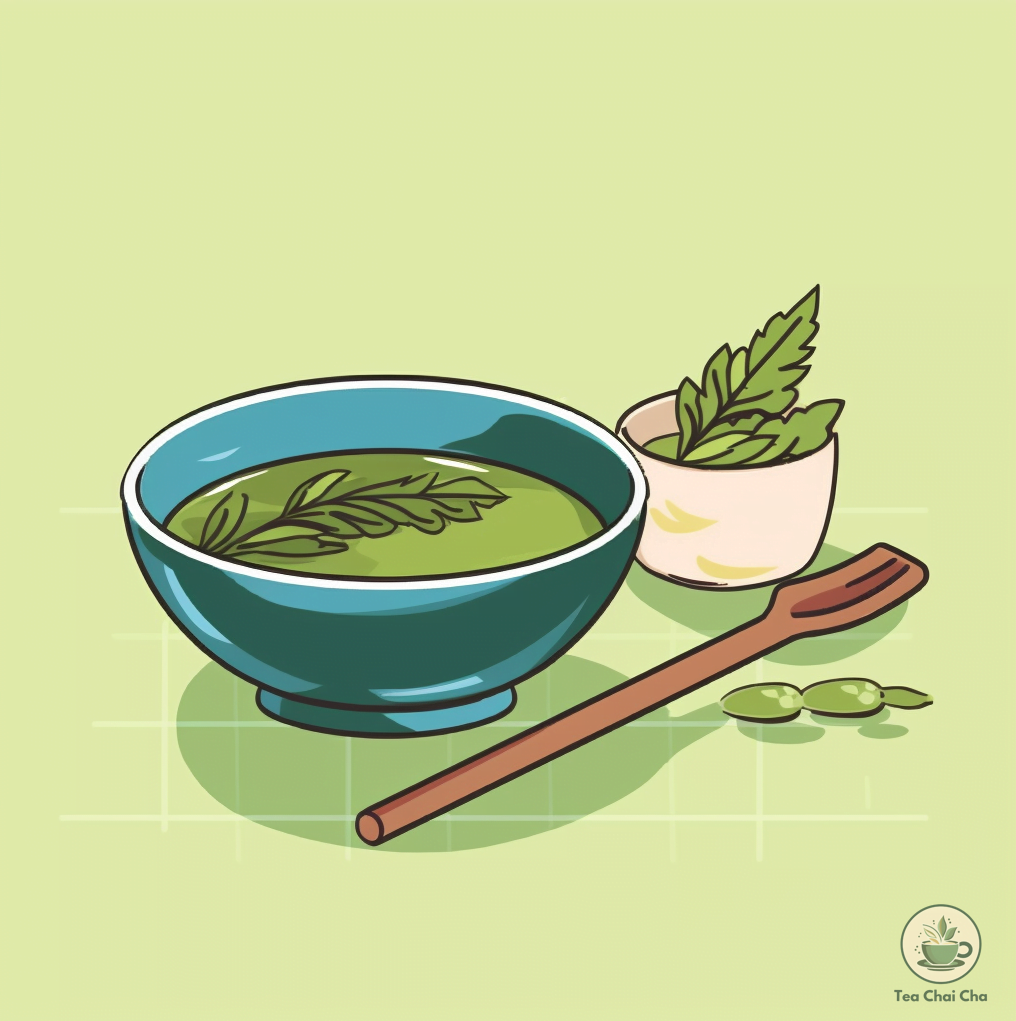Of course, green tea is really good for us and helps our body and mind in great ways. But guess what? There’s a trick to making it taste just right.
If your green tea ends up tasting a bit like grass or too bitter, then wait a sec… you might not be making it the best way.
And that’s a bummer because you could miss out on some good stuff for your body.
Still, making green tea the right way isn’t hard. You just need to pay attention to a few things.
I know firsthand how easy it is to end up with a cup that tastes like a freshly mowed lawn or overly bitter.
But don’t worry, there’s a simple fix to make sure you’re sipping on all those great tea benefits.
In this guide, you’ll get tips on making the perfect cup of green tea, green tea types to try, flavor variations, food pairings, and much much more..!
What Is Green Tea?
Green tea, also known as Camellia sinensis, is a type of tea that’s good for your health because it’s full of helpful things called antioxidants.
These antioxidants are like tiny protectors for your body.
Even though green tea, black tea, and oolong tea all come from the same tea plant, green tea is made in a special way.
The people who pick the tea leaves have to choose the youngest and freshest leaves from the top of the plant.
These leaves are treated in a special process to keep them from turning brown.
This special way of picking and making the tea is what makes green tea so good for us.
In China, the green tea leaves are smaller, and in Assam, India, they’re bigger. But both kinds of leaves give us the same good things for our health.
Green Tea Benefits
But why does everyone talk about green tea like it’s magic?
Well, it’s all about the good stuff called catechins – they’re like tiny defenders for our bodies.
The most powerful one is called EGCG (that’s a tongue-twister!).
This superhero EGCG blocks bad things like cells going crazy, signals that lead to cancer, piling up of fat, and mean germs that want to attack us.
It even keeps our precious DNA safe, fights tiredness, and boosts our immune system.
And that’s not all – these antioxidants also team up to fight diseases like heart troubles, brain issues, kidney problems, and even things like diabetes, obesity, skin troubles, and cancer.
So, that’s the scoop on green tea.
Remember, it’s not just a tasty drink, it’s like a friendly shield for our body against all sorts of troubles!
Now let’s talk about the tea history, a bit!
Green Tea History
Before we get started, let’s send a big thank you to Emperor Shen Nong from ancient China.
Way back in 2737 B.C., he accidentally dropped some tea leaves into his hot water, creating the first green tea.
That lucky mistake gave us a refreshingly different drink!
Those clever Chinese monks then shared the secret wherever they roamed, making green tea super popular.
Thanks to them, we now get to enjoy this awesome source of antioxidants every day.
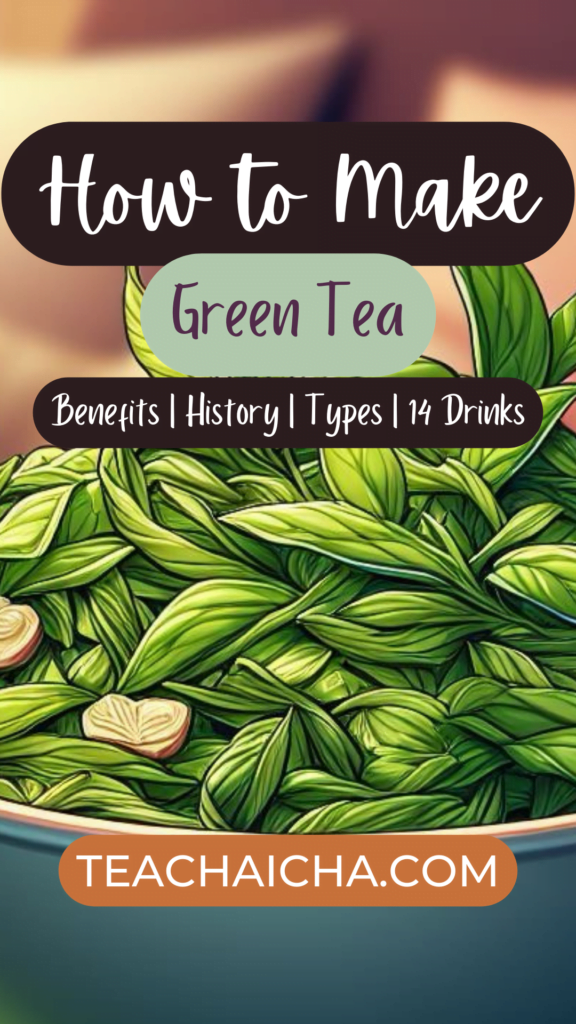
What You Need to Make Green Tea
When it comes to making a refreshing cup of green tea, you don’t need a lot of fancy stuff. Here’s what you’ll need:
Ingredients
Green Tea Leaves or Tea Bags: These are the stars of the show. You can choose loose green tea leaves or convenient tea bags, whichever you prefer.
Water: Good old water is what you’ll use to brew your tea.
Make sure it’s clean and preferably filtered for the best taste.
Optional Add-ins: If you like, you can add a touch of honey, a slice of lemon, or some fresh mint leaves to enhance the flavor.
Equipment
Kettle or Pot: You’ll need something to heat up your water. A kettle or a pot on the stove will do the job.
Teapot or Teacup: To steep your tea leaves in hot water. If you’re using tea bags, a teacup will work just fine.
Tea Infuser (Optional): If you’re using loose tea leaves, a tea infuser is handy to keep the leaves separate from the tea while brewing.
Strainer: If you don’t have a teapot with an infuser, a small strainer can help catch any loose tea leaves when pouring into your cup.
Timer: This can be your phone or a simple kitchen timer. It’s important for steeping the tea for just the right amount of time.
Spoon: For stirring and scooping tea leaves if you’re using loose ones.
Kettle Gloves or Pot Holders: These will help you handle hot pots and kettles safely.
Learn about Tea Accessories and Their Uses!
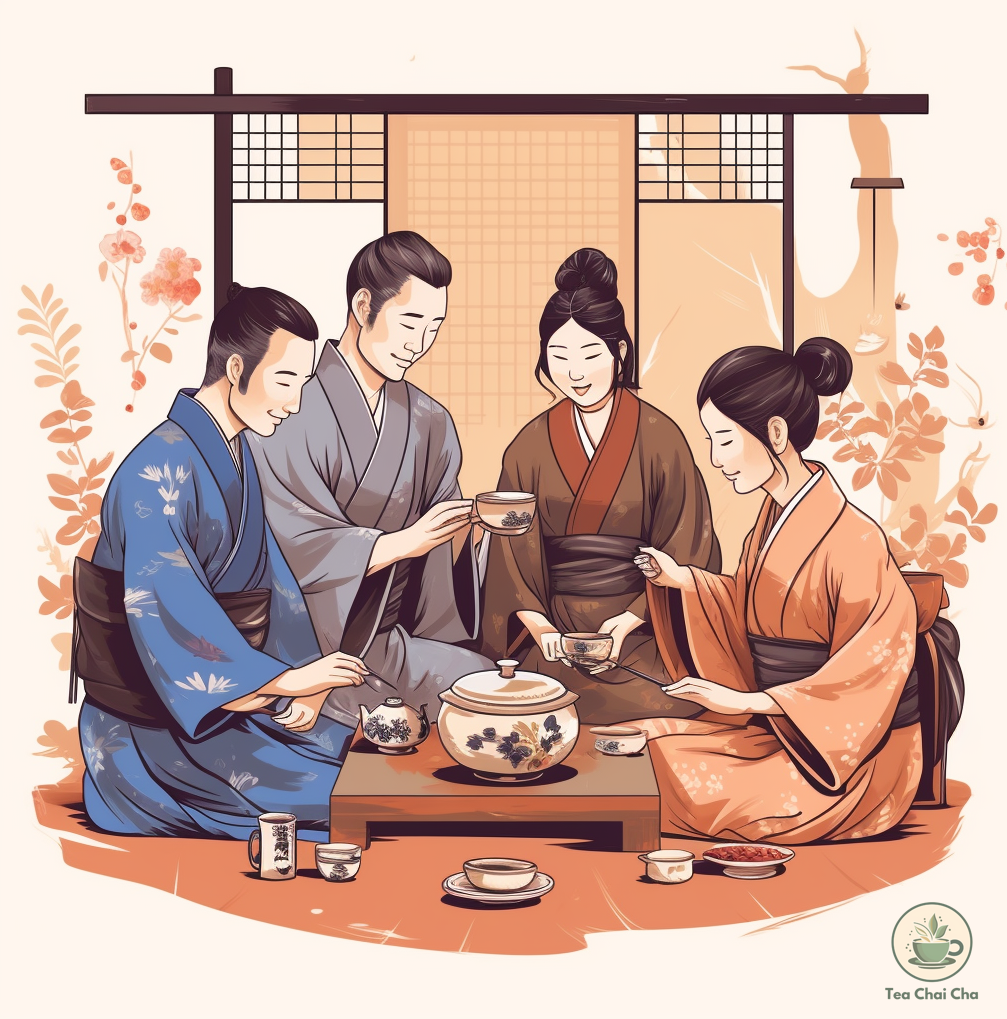
How to Make Green Tea – Step-by-Step Guide
Here’s your easy guide to make a just right cup of green tea. Just follow these steps and you’ll be sipping on a healthy cup of green tea in no time!
Step 1: Choose Your Green Tea Leaves
To make delicious green tea, you first need to choose the right type of green tea leaves.
There are various options, such as sencha, matcha, and gunpowder green tea.
Each type has its own unique flavor and aroma.
If you’re new to green tea, I suggest starting with sencha, as it’s a classic and widely enjoyed variety.
Step 2: Boil Fresh Water
Using fresh water is essential for making good tea.
Fill your kettle with cold, fresh water and bring it to a boil.
Once the water reaches a rolling boil (212°F or 100°C), let it cool down for a minute or two until it reaches a temperature of 80-85°C (176-185°F) before pouring it over the tea leaves.
This helps to prevent scalding the delicate leaves and retains the tea’s flavors.
Step 3: Preheat Your Teapot or Teacup
If you have a teapot or teacup, it’s a good idea to preheat it by rinsing it with a bit of hot water.
This step ensures that your tea stays warm for longer once it’s brewed.
Step 4: Add Green Tea Leaves
Place about a teaspoon of green tea leaves into your teapot or teacup for each cup you plan to make.
Adjust the amount based on your preference for strength.
If you’re using tea bags, one bag per cup is usually sufficient.
Step 5: Pour Water Over the Leaves
Carefully pour the hot water over the tea leaves.
Remember not to use boiling water directly on the leaves, as it can make the tea taste bitter.
Allow the leaves to steep in the hot water for about 1 to 3 minutes, depending on your taste preference.
Shorter steeping times will result in a milder flavor, while longer times will make the tea stronger.
Step 6: Strain or Remove Tea Bags
If you use loose tea leaves, strain the tea into your teacup to remove the leaves.
If you use tea bags, simply remove the bags from the cup. Be gentle to avoid any splashes.
Step 7: Enjoy Your Green Tea
Now, your green tea is ready to be enjoyed!
Take a moment to inhale the pleasant aroma and savor the delicate taste.
You can drink it plain or add a touch of honey, lemon, or mint for extra flavor. Enjoy it while it’s warm.
Step 8: Re-steep (Optional)
Some types of green tea, like high-quality sencha, can be re-steeped multiple times.
Don’t rush to throw away the tea leaves if you’re using loose tea; you can enjoy another cup or two by re-steeping them.
Just increase the steeping time slightly with each subsequent infusion.
Step 9: Experiment and Explore
Remember, making green tea is all about personal preference.
You can adjust the amount of tea leaves, water temperature, and steeping time to find the perfect balance that suits your taste.
Feel free to explore different types of green tea and find the one that becomes your favorite.
9 Green Types to Try!
Whether you’re drawn to the traditional elegance of Matcha or the subtle sweetness of Dragonwell, there’s a green tea type waiting to be savored.
Here is a brief overview of some of the most popular types of green tea:
1. Sencha
- Origin: Japan
- Properties: Made from young tea leaves, steamed and rolled.
- Taste: Fresh, grassy, and slightly astringent.
- Notes: Common everyday green tea in Japan, rich in antioxidants.
Read more – How to Make Sencha Tea
2. Matcha
- Origin: Japan
- Properties: Shade-grown leaves ground into a fine powder.
- Taste: Creamy, slightly bitter, with umami flavors.
- Notes: Used in traditional Japanese tea ceremonies, provides a concentrated dose of nutrients.
Read more – How to Make Matcha Tea
3. Dragonwell (Longjing)
- Origin: China (Hangzhou)
- Properties: Flat, broad leaves that are pan-fired.
- Taste: Mellow, chestnut-like flavor with a slightly sweet aftertaste.
- Notes: One of China’s most famous teas, known for its delicate aroma.
4. Gunpowder
- Origin: China
- Properties: Leaves are tightly rolled into small pellets.
- Taste: Strong, smoky, and slightly earthy.
- Notes: Holds its flavor well, often used as a base for mint tea in Morocco.
5. Gyokuro
- Origin: Japan
- Properties: Shade-grown like Matcha, but leaves are not ground.
- Taste: Sweet, umami-rich, and less astringent than other green teas.
- Notes: High in caffeine, prized for its complex flavor profile.
6. Hojicha
- Origin: Japan
- Properties: Made from roasted green tea leaves.
- Taste: Toasty, nutty, and less grassy than other greens.
- Notes: Low in caffeine due to the roasting process, great evening option.
7. Bancha
- Origin: Japan
- Properties: Made from mature tea leaves.
- Taste: Mild, slightly earthy, and less astringent.
- Notes: Often enjoyed as an everyday tea in Japan.
8. Jasmine Green Tea
- Origin: China (Jasmine-scented)
- Properties: Green tea leaves scented with jasmine flowers.
- Taste: Floral, fragrant, and slightly sweet.
- Notes: Perfect balance of floral aroma and green tea flavor.
Read more – How to Make Jasmine Tea
9. Moroccan Mint Tea
- Origin: Morocco
- Properties: Typically made with Gunpowder green tea and fresh mint leaves.
- Taste: Refreshing, minty, and slightly grassy.
- Notes: Often sweetened with sugar, served as a sign of hospitality.
Can’t Decide Which One to Try? Lemme Help!
| Green Tea Type | Flavor Profile | Caffeine Level | Beginner Level | Notable Features |
| Sencha | Fresh, grassy | Moderate | Beginner | Everyday Japanese green tea |
| Matcha | Creamy, umami | High | Intermediate | Used in ceremonies, potent |
| Dragonwell | Mellow, nutty | Moderate | Beginner | Famous Chinese green tea |
| Gunpowder | Strong, smoky | Moderate | Beginner | Good base for mint tea |
| Gyokuro | Sweet, umami-rich | High | Advanced | Shade-grown, complex flavors |
| Hojicha | Toasty, nutty | Low | Beginner | Roasted, great for evenings |
| Bancha | Mild, earthy | Low | Beginner | Everyday Japanese choice |
| Jasmine Green | Floral, fragrant | Moderate | Beginner | Jasmine-scented, aromatic |
| Moroccan Mint | Refreshing, minty | Moderate | Beginner | Minty twist on Gunpowder |
Green Tea Hot or Cold?
When it comes to green tea, you’ve got options for both hot and cold sips. Let’s break it down:
Hot Green Tea
If you’re looking for a soothing, cozy drink, go for hot green tea. It’s like a warm hug for your taste buds.
Choose a classic green tea like “Sencha” or “Dragonwell” for a grassy and slightly sweet flavor.
You can also try “Matcha,” a powdered green tea that’s whisked into hot water, giving you a rich, earthy taste.
Cold Green Tea
When the weather’s warm or you’re craving a refreshing pick-me-up, iced green tea is the way to go.
Opt for teas labeled “Iced Green Tea” or “Cold Brew Green Tea.” These are specially crafted to be brewed and served cold.
You might also consider “Jasmine Green Tea” for a floral twist or “Citrus Green Tea” for a zesty kick.
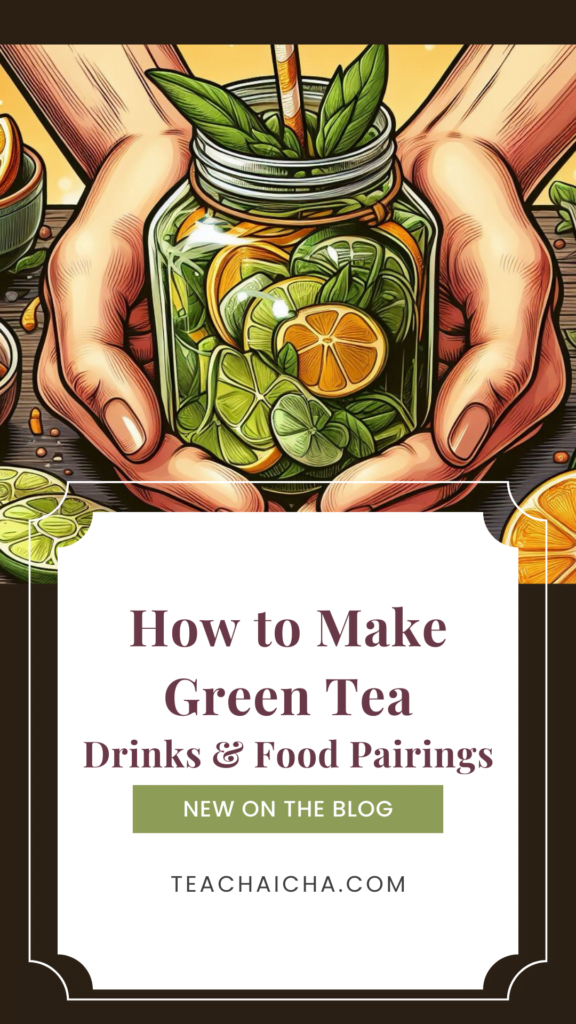
Brewing Guide for Different Types of Green Tea (Iced and Hot)
Here’s a brewing guide for different types of green tea, both for hot and iced preparations.
Keep in mind that these are general guidelines, and you can adjust the parameters based on your taste preferences.
| Green Tea Type | Water Temperature | Steeping Time for Hot Tea | Steeping Time for Iced Tea |
| Sencha | 175°F (80°C) | 1-2 minutes | 2-3 minutes |
| Matcha | 175°F (80°C) | N/A (whisked in water) | N/A (whisked with ice) |
| Dragonwell | 175°F (80°C) | 2-3 minutes | 3-4 minutes |
| Gunpowder | 175°F (80°C) | 2-3 minutes | 3-4 minutes |
| Gyokuro | 140°F (60°C) | 1-2 minutes | N/A |
| Hojicha | 175°F (80°C) | 2-3 minutes | 3-4 minutes |
| Bancha | 175°F (80°C) | 1-2 minutes | 2-3 minutes |
| Jasmine Green Tea | 175°F (80°C) | 2-3 minutes | 3-4 minutes |
| Moroccan Mint Tea | 175°F (80°C) | 2-3 minutes | 3-4 minutes |
Brewing Tips
- Use fresh, filtered water for the best flavor.
- For hot tea, let the water cool slightly after boiling before pouring it over the tea leaves.
- Adjust steeping times based on your taste preference; shorter steeping times for milder flavor, longer for stronger.
- For iced tea, you can steep the tea with hot water and then chill it in the refrigerator or pour it directly over ice.
- Experiment with the tea-to-water ratio to find your desired strength.

How to Make Iced Green Tea
Making iced green tea is super refreshing, and I’d be happy to guide you through a couple of methods using tea leaves and tea bags.
Method 1: Iced Green Tea with Tea Leaves
Ingredients:
- 1 tablespoon green tea leaves
- 1 cup hot water
- Sweetener (optional)
- Ice cubes
- Lemon slices or mint leaves for garnish (optional)
Steps:
1. Brew the Tea: Start by adding 1 tablespoon of green tea leaves into a teapot or a heatproof container.
Pour 1 cup of hot water over the leaves. Let it steep for about 3-4 minutes. If you like your tea stronger, you can steep it a bit longer.
2. Sweeten (Optional): If you like your tea sweet, you can add a little honey, sugar, or any sweetener of your choice to the hot tea. Stir until it’s dissolved.
3. Cool Down: Allow the brewed tea to cool down to room temperature.
You can leave it on the counter or pop it in the fridge for quicker cooling.
4. Serve: Once the tea is cool, fill a glass with ice cubes. Pour the cooled tea over the ice. You can add lemon slices or a sprig of mint for some extra zing and freshness.
Method 2: Cold Brew Iced Green Tea with Tea Bags
Ingredients:
- 2-3 green tea bags
- 1 quart cold water
- Sweetener (optional)
- Lemon wedges or cucumber slices for a cool twist (optional)
Steps:
1. Combine Tea Bags and Water: Place 2-3 green tea bags in a pitcher or large jar.
Add 1 quart (about 4 cups) of cold water to the pitcher. You can use 4 tablespoons of green tea leaves as well.
2. Refrigerate: Cover the pitcher and put it in the fridge.
Let the tea bags steep in the cold water for at least 4 hours or overnight. The longer it steeps, the stronger the flavor will be.
3. Remove Tea Bags: Once the tea has steeped to your desired strength, take out the tea bags.
4. Sweeten (Optional): If you like, you can add sweetener to the cold-brewed tea. Stir until it’s well mixed.
5. Serve: Fill a glass with ice and pour the cold-brewed tea over it.
You can also add lemon wedges or cucumber slices to enhance the taste and add a refreshing touch.
Feel free to choose the method that suits your preferences best.
The first method gives you a quicker option with a hot brew, while the second method offers a gentler, milder flavor through cold brewing.
9 Factors That Affect the Flavor of Green Tea
Worried about what can affect the flavor of your green tea? Here are some factors that might have a toll on your green tea leaves.
While some things are in your hands, others are out of your control.
1. Growing Conditions
The environment where tea plants grow influences taste.
Factors like altitude, temperature, humidity, and soil composition impact the chemical composition of the leaves, resulting in distinct flavor profiles from different regions.
2. Leaf Age
The age of tea leaves used affects flavor complexity.
Younger leaves, often plucked in the first flush, offer a nuanced and lighter taste.
Older leaves, from later harvests, can have a stronger and more robust flavor.
3. Steeping Time
The duration you steep the tea leaves in hot water directly impacts the flavor.
If steeped for too long, the tea can become overly bitter as more tannins are released.
Conversely, if steeped for too short a time, the flavor might remain underdeveloped and weak.
4. Water Temperature
The temperature of the water you use plays a pivotal role.
For green tea, it’s recommended to use water that’s around 175-185°F (80-85°C).
Water that’s too hot can scorch the delicate leaves, resulting in a bitter taste.
5. Water Quality
The quality of the water used for brewing matters.
Clean, filtered water is ideal, as impurities or minerals in tap water can interfere with the tea’s natural flavors and aromas.
6. Brewing Vessel
The choice of teapot or cup also contributes to the flavor experience.
Porcelain or glass vessels are commonly preferred for green tea, as they don’t retain or impart strong flavors that might alter the tea’s taste.
7. Caffeine Content
Green tea contains caffeine, which can introduce a slightly bitter note to the flavor profile.
Being aware of your caffeine tolerance can help you enjoy green tea without any undesirable bitterness.
8. Additives
The addition of sugar, honey, milk, or other flavorings can significantly alter the taste of green tea.
While some people enjoy these additions, they can mask the tea’s natural flavors.
9. Storage
Proper storage of tea leaves is vital to maintaining their freshness and flavor.
Storing tea in an airtight container away from light, moisture, and strong odors preserves its delicate taste over time.
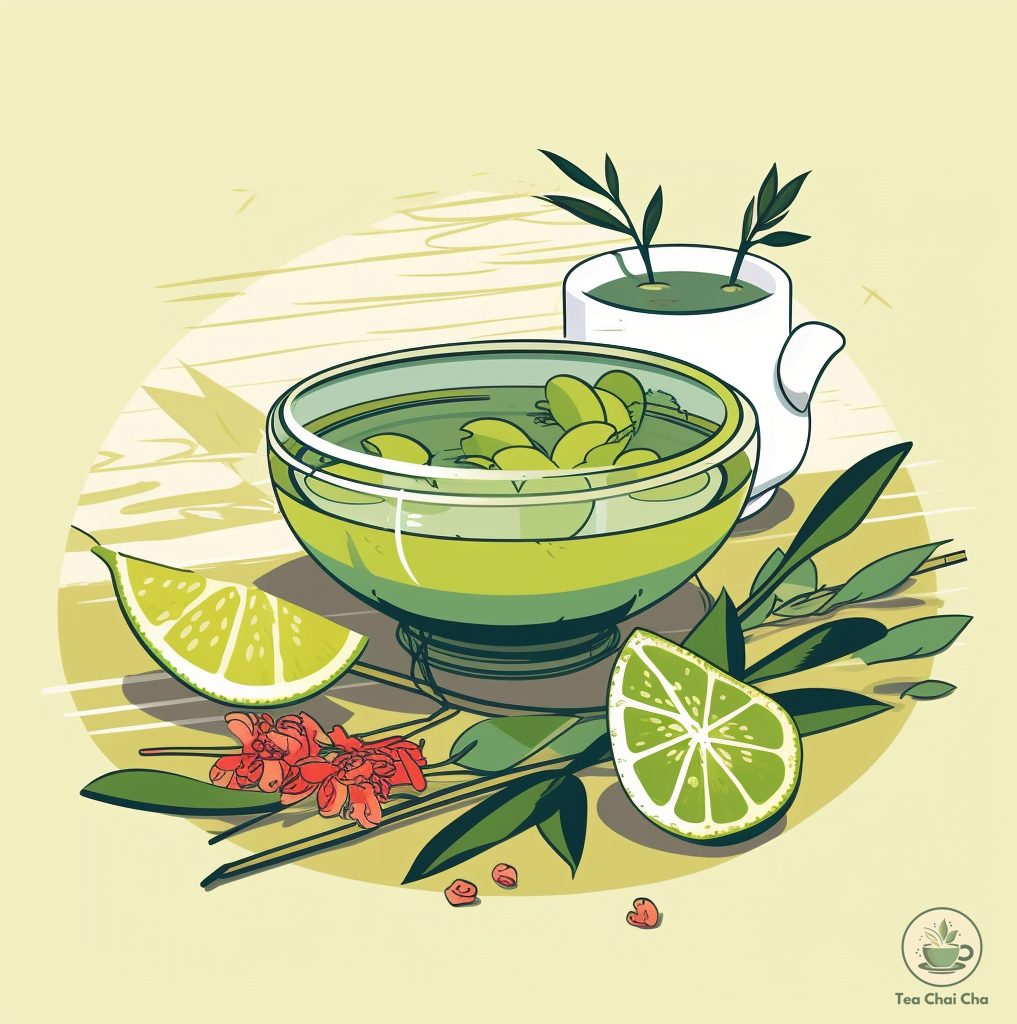
What to Do If Green Tea Is Overly Brewed and Tastes Bad?
If it happens to you as well (yup, I faced it, too!), I have some expert tips for you to save your green tea from bitter enemies like a superhero!
So, here’s what I’d do (actually, have done these and learned my lesson) if it happens to me (no! I don’t want to taste that bitterness again)
Adjust Brew Time
If my green tea tastes too strong or bitter, I’d first try brewing it for a shorter time.
Steeping it for a shorter period, like around 1-2 minutes, can help tone down the bitterness.
Lower Water Temperature
I’d make sure to use water that’s not too hot. Boiling water can make green tea taste bitter.
Instead, I’d let the water cool down a bit (around 160-175°F or 70-80°C) before pouring it over the tea leaves.
Dilute with Water
If the taste is still strong, I’d simply add some hot water to my cup to dilute the tea’s intensity.
This can help balance out the flavors and reduce the bitterness.
Add a Splash of Cold Water
To quickly cool down overly brewed tea, I’d add a small amount of cold water to my cup.
This can mellow out the flavors and make it more enjoyable.
Try Adding Honey or Lemon
If the bitterness is still too much, I’d consider adding a little bit of honey or a squeeze of lemon to the tea.
These natural additives can add some sweetness or tanginess that can help offset the bitterness.
Experiment with Ice
I might pour the overly brewed tea over ice to make an iced version.
Sometimes, cooling down the tea can mellow out the bitterness and create a refreshing drink.
Mix with Another Tea
If the taste is too overwhelming, I could try mixing the overly brewed green tea with a milder tea, like white tea or herbal tea.
This can help balance the flavors and create a more enjoyable blend.
Don’t Store It
Overly brewed tea can become even more bitter if left to sit for too long. So, I’d avoid storing it and aim to drink it as soon as possible.
Learn from It
Lastly, I’d take it as a learning experience.
Adjusting brewing times and water temperatures are crucial skills for making a perfect cup of tea.
Next time, you need to be more mindful and avoid over-brewing.
How to Make Green Tea Taste Good
When it comes to making green tea taste great, there are a few tricks I’ve found that really work.
1. Lemon Zest Twist
Squeezing a little fresh lemon juice into my green tea gives it a tangy kick.
The citrusy notes balance out the earthiness of the tea.
I like to add lemon zest too, as it adds a burst of fragrance. This works well with most types of green tea.
2. Honey Sweetness
A drizzle of honey does wonders for my green tea. It adds a touch of natural sweetness that complements the tea’s grassy flavors.
I find this combo soothing and delicious. Any green tea variety can benefit from a touch of honey.
3. Minty Freshness
Adding a sprig of fresh mint to my green tea creates a refreshing fusion.
The coolness of the mint leaves livens up the tea and makes it feel invigorating.
This is especially delightful with Japanese green teas like Sencha or Genmaicha.
4. Ginger Spice Kick
A pinch of freshly grated ginger adds warmth and spice to my green tea.
The slight spiciness plays well with the tea’s natural taste. It’s a cozy choice, especially on colder days.
Sencha or Gunpowder green tea pairs nicely with ginger.
5. Fruity Infusion
Tossing in a few slices of your favorite fruits, like berries or peaches, infuses the green tea with natural fruity flavors.
The result is a delightful and light concoction that’s perfect for a summer refreshment.
This works with various green tea types.
Read my detailed guide on How to Make Green Tea Taste Good!
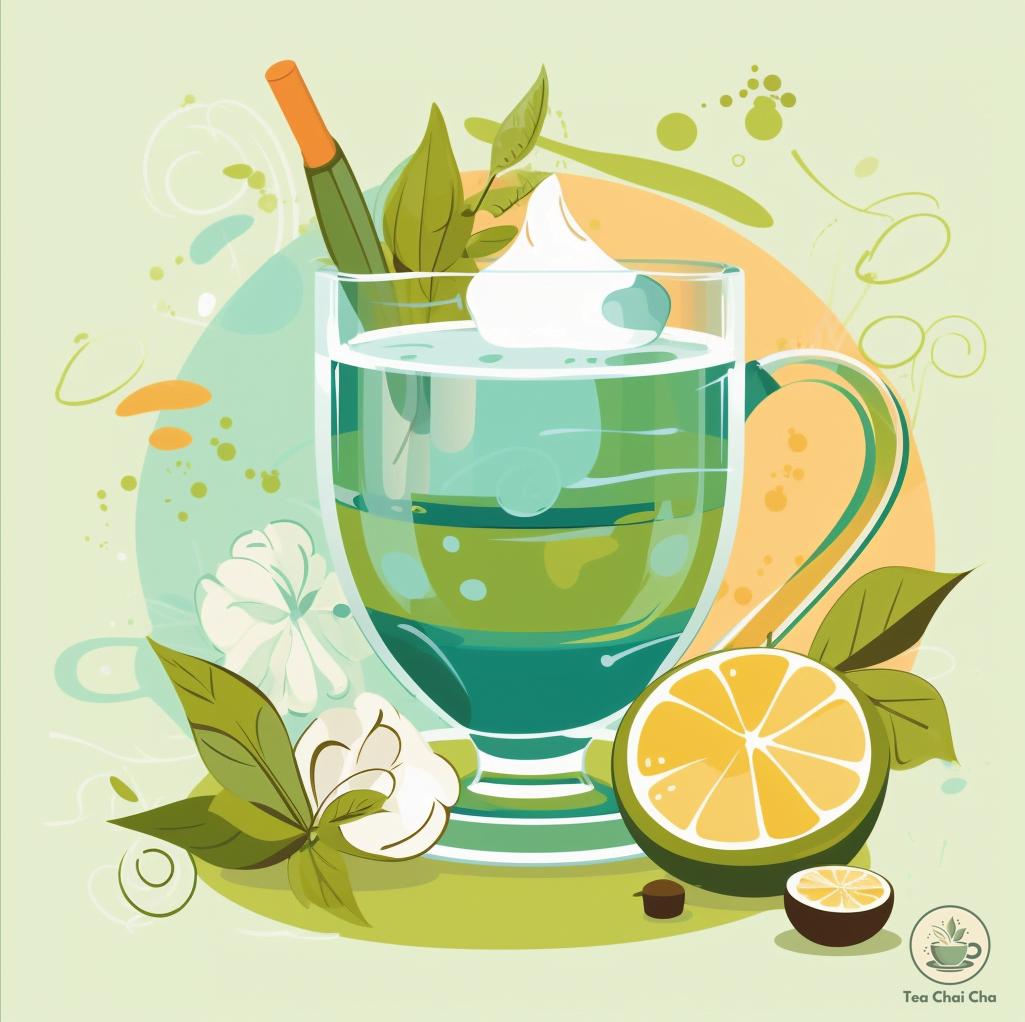
14 Delicious Drinks with Green Tea – Green Tea Variations
In addition to improving the taste of green tea, here I have some oh-so-delicious drinks that you can make with green tea!
1. Iced Green Tea Lemonade
Combining green tea with freshly squeezed lemon juice and a touch of sweetener over ice creates a zesty and cooling drink.
It’s a fantastic way to beat the heat and enjoy the benefits of green tea.
2. Honey Mint Green Tea
Brewing green tea with a touch of honey and fresh mint leaves, then serving it over ice, yields a refreshing and lightly sweet beverage.
It’s like a sip of nature’s goodness.
3. Ginger Peach Green Tea Smoothie
Blending green tea with ripe peaches, a hint of ginger, and some ice results in a smoothie that’s both invigorating and satisfying.
It’s a balanced mix of flavors and textures.
4. Fruity Green Tea Infusion
Infusing green tea with a medley of sliced fruits, such as strawberries, oranges, and blueberries, creates a colorful and flavorful drink that’s as visually appealing as it is tasty.
5. Coconut Green Tea Cooler
Brew light and delicate green teas like “Dragonwell” or “Biluochun” for this cooler.
Their subtle flavors won’t overpower the coconut and lime.
Mix the chilled tea with coconut water and a splash of lime juice for a tropical twist that’s sweet and tangy.
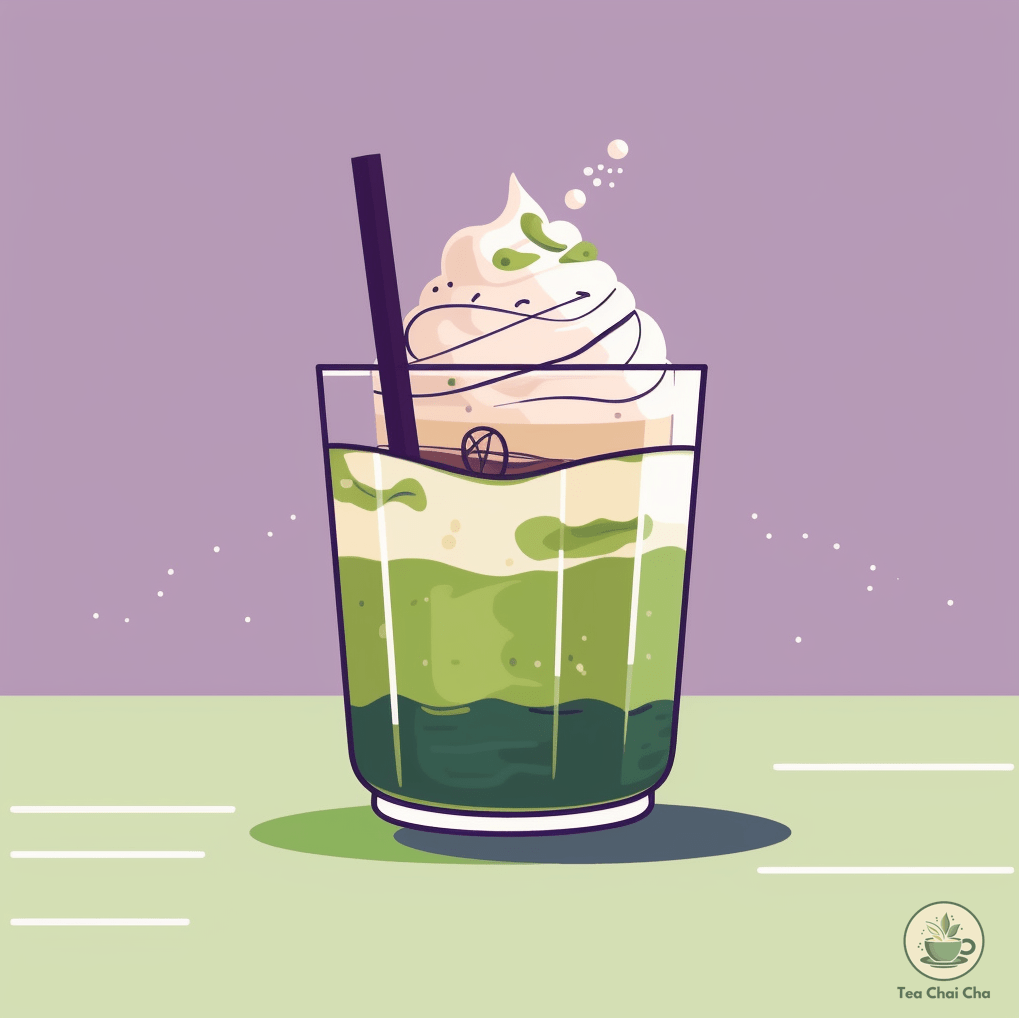
6. Matcha Latte
Choose high-quality ceremonial grade matcha for this latte.
Whisk the matcha powder with hot water, then add frothed milk.
This creamy and vibrant drink combines the rich, earthy flavor of matcha with the comforting creaminess of milk.
7. Pomegranate Green Tea Spritzer
Opt for a green tea like “Sencha” or “Gunpowder” as the base for this spritzer.
Its grassy notes pair well with the fruity pomegranate.
Infuse the green tea with pomegranate juice and a splash of sparkling water for a fizzy and refreshing treat.
8. Lavender Green Tea
Choose a milder green tea like “Houjicha” or “Genmaicha” to balance the floral lavender.
Brew the green tea and infuse it with dried lavender buds.
Add a touch of honey and a squeeze of lemon for a soothing and aromatic elixir.
9. Citrusy Green Tea Shot
Pick a vibrant and fresh green tea such as “Sencha” or “Mao Feng.”
Create a shot by mixing a concentrated brew of green tea with a splash of orange or grapefruit juice.
It’s an invigorating way to start your day.
10. Vanilla Almond Green Tea
Opt for a slightly nutty green tea like “Tamaryokucha” or “Bi Luo Chun” for this creation.
Brew the green tea and add a drop of vanilla extract and a splash of almond milk.
This smooth and nutty drink is perfect for a cozy moment.
11. Green Tea Mojito Mocktail
Choose a fresh and grassy green tea like “Sencha” for this mocktail.
Muddle fresh mint leaves and lime slices in a glass, then add brewed green tea and a splash of club soda.
It’s a refreshing and flavorful drink.
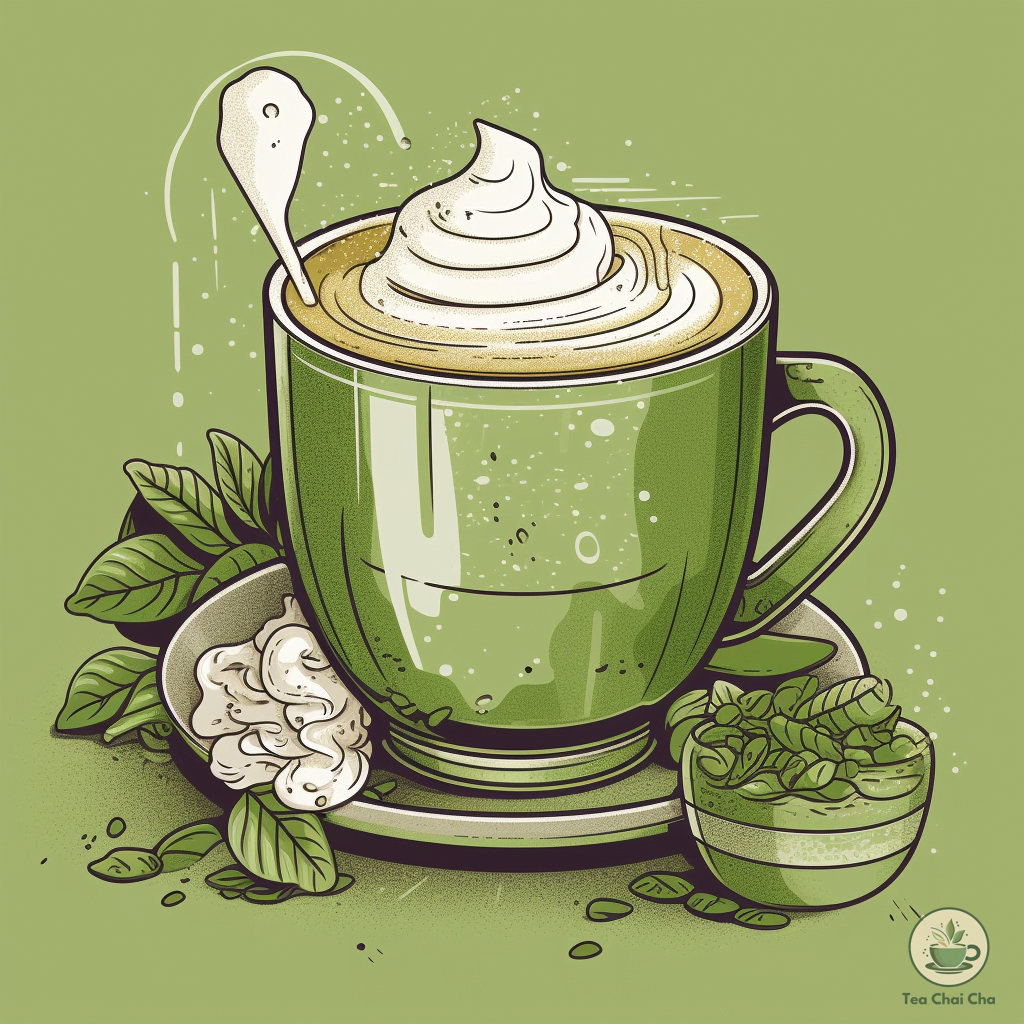
12. Chai-Spiced Green Tea Latte
Pick a robust green tea like “Gunpowder” or “Genmaicha” that can stand up to the spices.
Infuse the green tea with warming chai spices like cinnamon, cardamom, and cloves.
Add frothed milk and a sprinkle of nutmeg for a comforting and aromatic latte.
13. Green Tea Frappé
Choose a green tea with natural sweetness, like “Matcha” or “Gyokuro.”
Blend the brewed green tea with ice, a touch of sweetener, and a splash of milk.
This icy treat is perfect for cooling off on a warm day.
14. Mango Green Tea Smoothie
Opt for a mellow green tea like “Bancha” or “Kukicha” for this smoothie.
Blend the green tea with ripe mango chunks, a dollop of Greek yogurt, and a bit of honey.
It’s a creamy and fruity concoction that’s both nourishing and delicious.

Green Tea Food Pairing
Let’s explore some tasty pairings with different types of green tea:
Sencha Green Tea
This tea has a refreshing, grassy flavor.
It goes well with light and fresh foods like sushi, sashimi, salads, and steamed seafood.
The tea’s brightness complements these dishes nicely.
Matcha Green Tea
Matcha has a rich, earthy taste.
It pairs wonderfully with foods that have a bit of sweetness or creaminess.
Think desserts like green tea ice cream, matcha-flavored pastries, and yogurt parfaits.
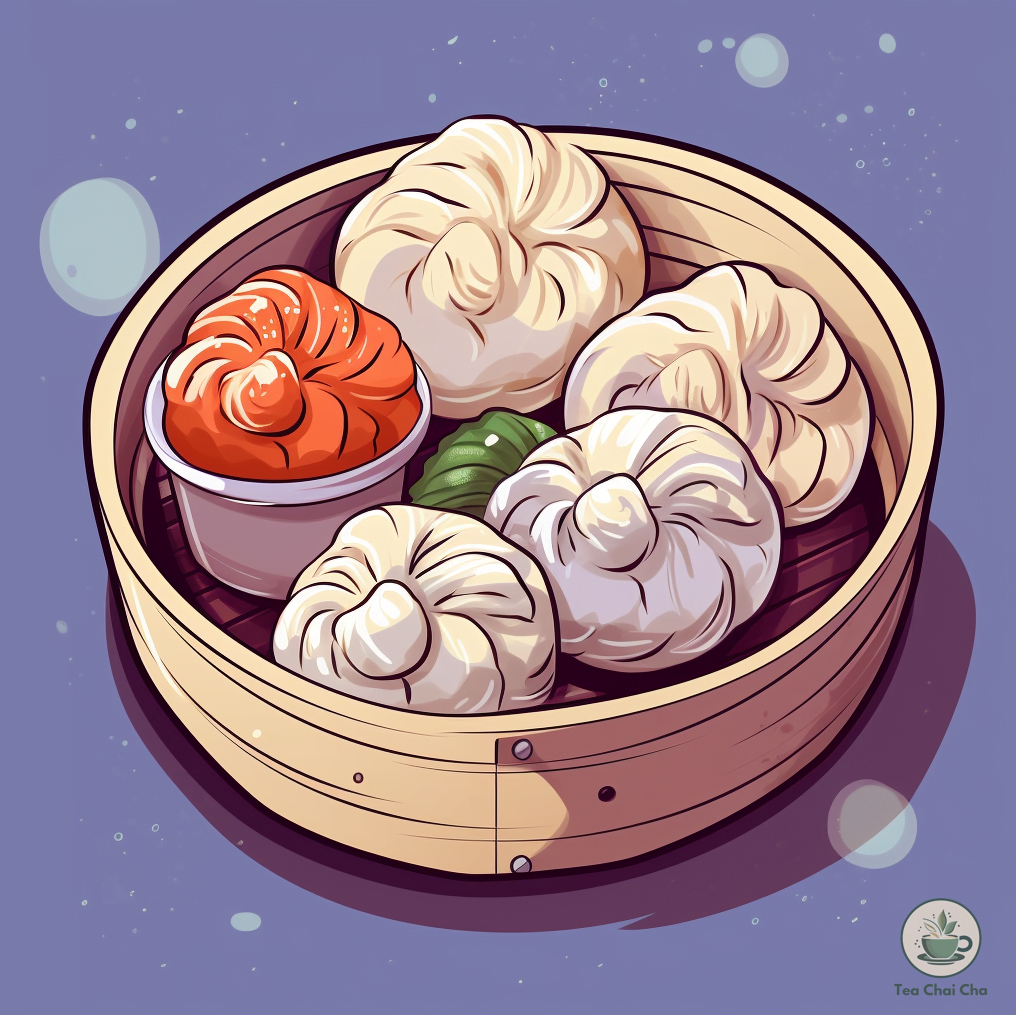
Jasmine Green Tea
With its floral aroma, jasmine green tea matches well with subtly flavored dishes.
Enjoy it alongside steamed dumplings, grilled chicken, or even light pasta with a citrusy dressing.
Hojicha
This roasted green tea offers a toasty, nutty flavor.
It’s great with heartier foods like roasted vegetables, grilled meats, and even dishes with a bit of smokiness.
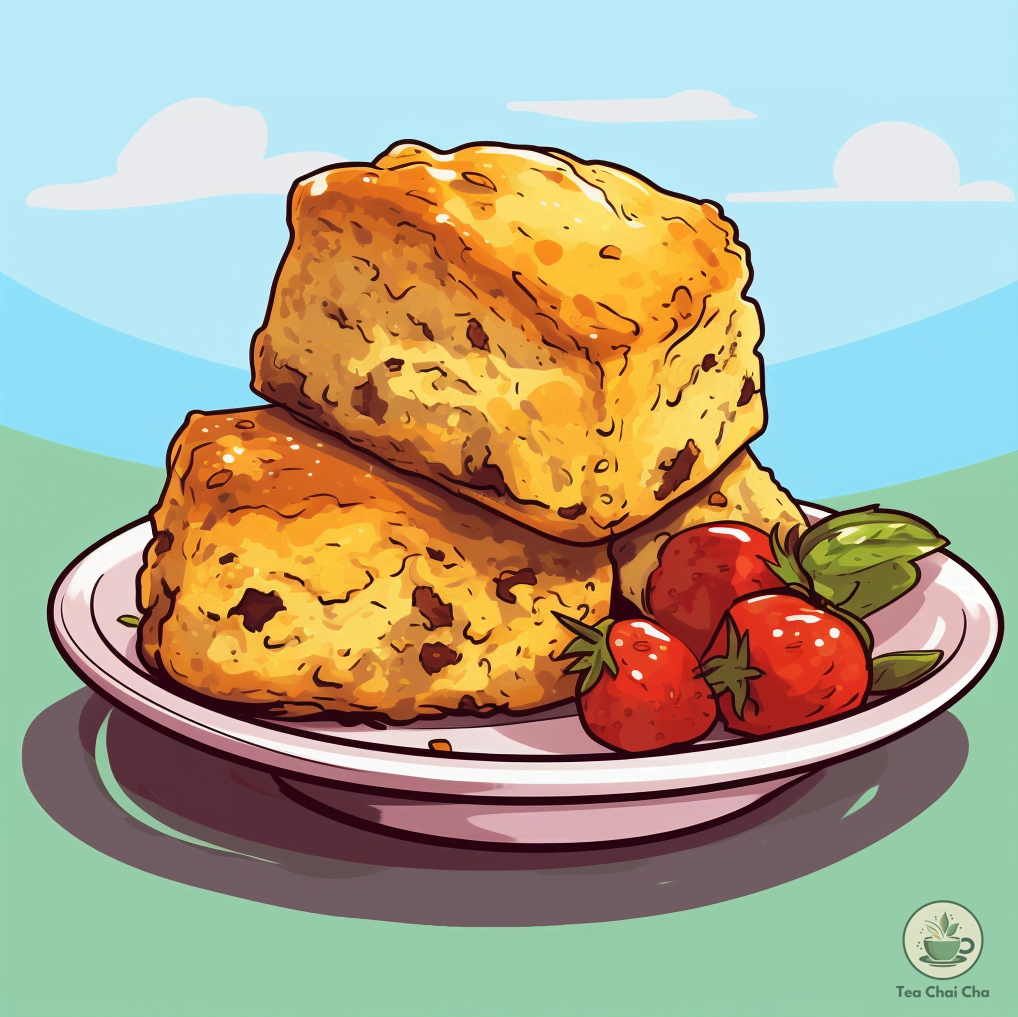
Genmaicha
Known for its mix of green tea and roasted brown rice, genmaicha pairs well with comfort foods.
Try it with rice dishes, stir-fries, and even savory pastries.
Gunpowder Green Tea
This tea has a slightly smoky taste and works well with bold flavors. Pair it with grilled meats, spicy dishes, and hearty stews.
Mint Green Tea
Minty and refreshing, this tea is perfect with light and cooling foods.
Have it with fruit salads, cucumber sandwiches, or even as a palate cleanser between courses.
When to Drink Green Tea
I like drinking green tea because it’s refreshing and good for me.
In the morning, before I start my day, I enjoy a cup of plain green tea.
It gives me a gentle boost of energy without making me feel jittery.
When I want to relax in the afternoon, I opt for a soothing cup of chamomile green tea. It helps me unwind and calms my mind.
In the evening, I go for decaffeinated green tea. It’s a nice way to unwind without worrying about caffeine disrupting my sleep.
Before bedtime, I sometimes have a cup of jasmine green tea. It has a delicate floral aroma that’s quite calming.
So, in the morning, plain green tea for a gentle kickstart, chamomile green tea for relaxation in the afternoon, decaffeinated green tea for the evening, and jasmine green tea before bed.
That’s my simple guide for when to enjoy different types of green tea.
Related
Classic Green Tea Recipe
Recipe by Tania FaysalCourse: DrinksCuisine: Chinese, Japanese1
servings5
minutes3
minutes0-5
kcal8
minutesHere's an easy recipe to answer your "how to make green tea". This recipe makes a tasty cup of green tea for one person!
Ingredients
1 teaspoon green tea leaves (or 1 tea bag)
1 cup water
Honey or sugar (optional)
Lemon slices (optional)
Directions
- Boiling Water: Start by boiling 1 cup of water. You can use a kettle or a pot on the stove. Let the water come to a rolling boil. If you have a thermometer, around 175°F to 185°F (80°C to 85°C) is perfect for green tea.
- Warming the Teapot/Cup: While the water is boiling, pour a little hot water into your teapot or cup to warm it up. Swirl it around and then pour it out. This helps maintain the tea's temperature.
- Adding the Tea: Place 1 teaspoon of green tea leaves in a tea infuser or directly into the teapot if it has a built-in strainer. If you're using tea bags, just pop one into your cup.
- Pouring Water: Once the water is ready, pour it gently over the tea leaves or tea bag. Fill your teapot or cup. This is where the magic begins!
- Steeping Time: Cover the teapot or cup with a lid or plate. Let the tea steep for about 2 to 3 minutes. Don't steep for too long, as green tea can become bitter.
- Remove the Tea: After steeping, take out the tea leaves or tea bag. You can place it on a small plate or saucer.
- Optional Additions: Now, if you like your tea a bit sweeter, you can add a teaspoon of honey or sugar. Stir until it dissolves. For a zesty kick, you can also add a slice of lemon.
- Enjoying Your Tea: Your classic green tea is ready to sip! Take in the soothing aroma and take small sips. Feel the warmth and the delicate flavor of the tea. It's a perfect moment to relax and unwind.
Recipe Video
Frequently Asked Questions (FAQs)
What does green tea taste like?
Green tea has a fresh and mildly grassy taste. Some types can be a bit earthy or slightly astringent. It’s generally light and refreshing.
Does green tea have caffeine?
Yes, green tea does contain caffeine, but the amount is generally lower compared to black tea or coffee. Green tea has 24-45 mg of caffeine. It gives a gentle energy boost without the strong jitters.
Is green tea a real tea?
Yes, green tea is a real tea. It comes from the leaves of the Camellia sinensis plant, just like black tea and other types of tea.
How many calories are in green tea?
Plain, unsweetened green tea usually has zero calories. However, if you add sweeteners or milk, the calorie count will increase.
Is 1 cup of green tea a day enough?
Drinking one cup of green tea a day can offer some health benefits, like antioxidants. But to experience more potential benefits, some people choose to have multiple (3-5) cups throughout the day.
Should I drink green tea every day?
Drinking green tea daily can be a good habit, as it contains antioxidants and can be part of a balanced lifestyle. Just remember to keep an eye on your overall caffeine intake and consider any individual sensitivities.
What is the difference between matcha vs green tea?
Matcha is a type of green tea, but it’s grown and processed differently. Matcha leaves are shaded before harvest, which boosts chlorophyll and amino acids.
The leaves are ground into a fine powder, which you whisk into hot water, consuming the entire leaf. This makes matcha more concentrated and potent than traditional steeped green tea.
So, matcha offers a more intense flavor and potentially higher antioxidants about 100x antioxidants of standard green tea.


